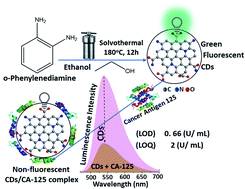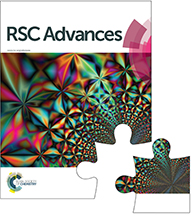Cancer antigen 125 assessment using carbon quantum dots for optical biosensing for the early diagnosis of ovarian cancer
Abstract
Fluorometric quantification of biological molecules is a key feature used in many biosensing studies. Fluorescence resonance energy transfer (FRET) using highly fluorescent quantum dots offers highly sensitive detection of the in-proximity wide variety of analyst molecules. In this contribution, we report the use of carbon quantum dots (CDs) for the ultrasensitive optical biosensing of cancer antigen 125 (CA-125) in the early malignant stage. This approach is based on monitoring the quenching of CDs luminescence at 535 nm by CA-125 after excitation at 425 nm and pH 10. The calibration of this method was performed in the concentration range of CA-125 from 0.01 to 129 U ml−1 (R2 = 0.99) with a detection limit of 0.66 U ml−1, which matches remarkably with the standard chemiluminometric method in control and real patient samples. The sensing mechanism for cancer antigen 125 assessment was discussed on the basis of fluorescence quenching of CDs and time-resolved photoluminescence spectroscopy. The current method is easy, sensitive, cost-effective and provides a wide range of validity, which helps in overcoming the limitations of high cost and time consumption exhibited by many other traditional clinical assays for CA-125 quantification.



 Please wait while we load your content...
Please wait while we load your content...